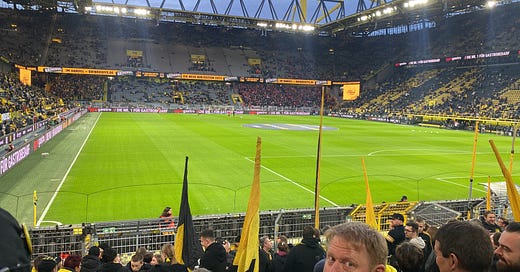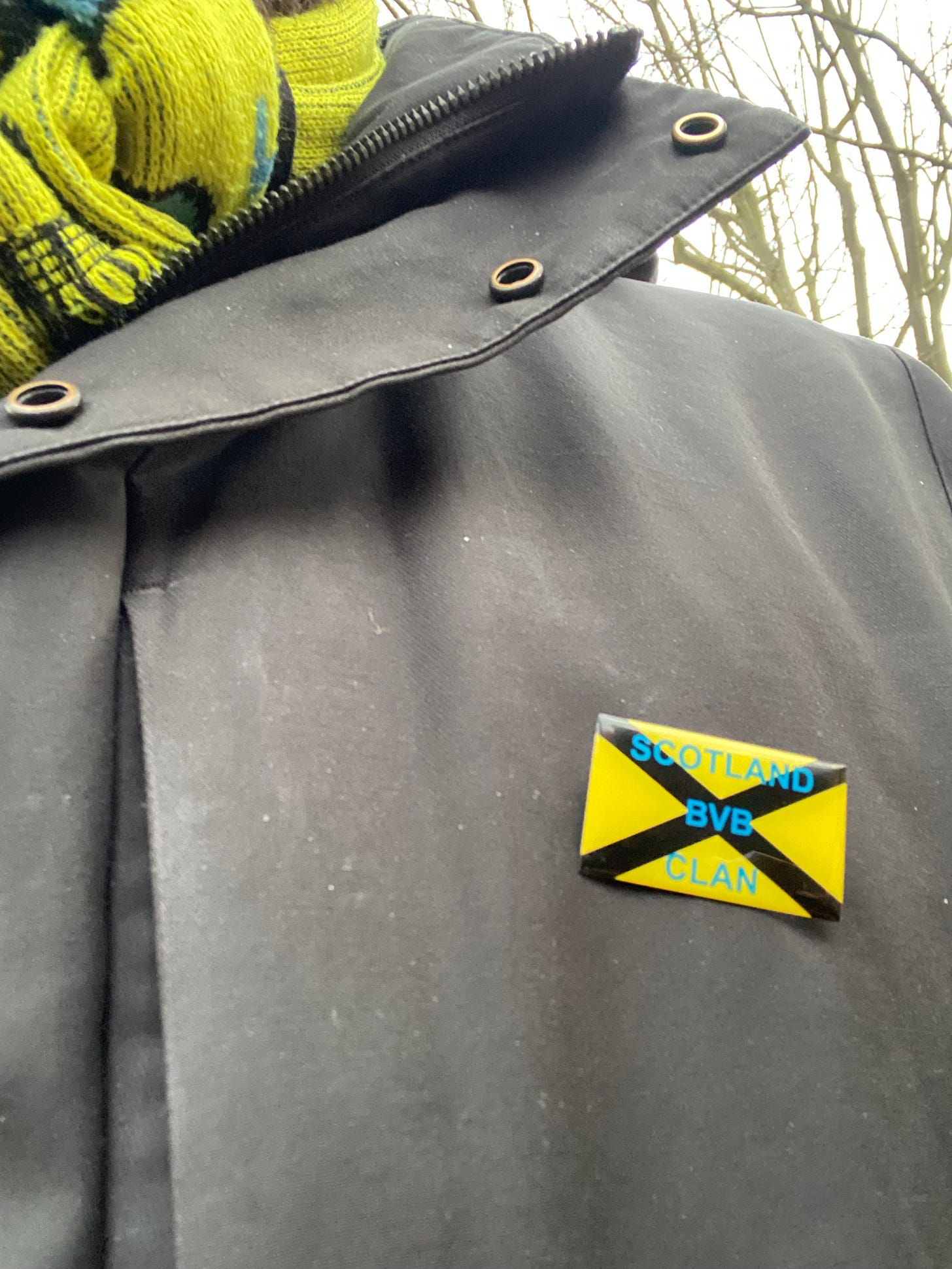Sitting in the opposition’s end is one of the worst experiences in football. Typically.
In the 2006/7 season, I did it twice. Once at the old Upton Park, where, under the leadership of Iain Dowie, Charlton started the season with a 3-1 loss. The bloke next to me kept asking me questions about which of West Ham’s signings I was excited about, where I thought ‘we’d’ finish that season and how shite the soft lads from the other side of the water were playing.
Then there was Stamford Bridge. Less chance of an earful, but no less depressing an experience. We lost 2-1. Jimmy Floyd Hasselbaink, who’d done the square root of fuck all in a Charlton shirt to that point, scored our only goal. He didn’t celebrate either. Dosser.
Bar one or two exceptions, including my trip to Wolfsburg earlier this season, I’ve avoided excursions behind enemy lines. Sitting on your hands, feigning half-hearted celebrations when your own team concedes, no chance of having a sing-song. That’s no way to enjoy a game of football.
Some offers are too good to turn down, however. Apropos of nothing, Ben, the Dortmund-mad half-English, half-Scotsmen who gamely showed me round the city for a piece I wrote on Bundesliga Christmas Carol services, shot me a text. “Fancy a ticket standing in the Yellow Wall for the Union game in Feb? Think I can get you in.” Principles be damned, you don’t turn that offer down.
You rarely hear positive reviews about Dortmund from foreign travellers. It’s a post-industrial city, in a post-industrial area. It isn’t particularly pretty to look at, and there are more celebrated tourist spots in Cologne and Düsseldorf just a few kilometres down the road.
That sells it short somewhat. Yes, it probably helps that I’m a football-obsessive, visiting a football-obsessed town, but there’s culture to enjoy, and a warmth to the people that have become accustomed to English-speaking groundhoppers seeking their fix. When Ben showed me round for my first visit we broke into a lengthy conversation with an elderly German couple who were curious to understand the appeal of BVB to blow-ins and out-of-towners. Our walk to the stadium took us past an opera house, university buildings and thriving bars, heaving with black-and-yellow-clad punters. Unlike other parts of the Ruhr, Dortmund managed to secure enough investment to keep its economy afloat when the demand for German steel slowed. When there’s enough cash sloshing about the place, buoyed by a football team that draws admiration and gets the locals out three times a month, cities typically fend alright for themselves, even if they aren’t the most glamorous.
This trip to Dortmund starts with Ben and his partner Doro showing me around the German Football Museum. I’ll go into the highlights of the exhibition in a later post, but I think the Allan Simonsen branded shampoo needs a shoutout here (check out my latest piece for Mundial on Simonsen’s short stay at The Valley here), as does the knowledge of my hosts. Not only did Ben and Doro spray facts at an engaging rhythm, they also managed to sprinkle in a light seasoning of bickering and critiques on each other’s patter that enhanced the experience immensely.
With a few hours to kill before kickoff, we entered Ben’s typical pre-game routine. Pommes in town, walk through Alter Markt, stop at The Londoner for a pint, pilsner from the späti before setting up camp in the beer garden at Rote Erde. The old stadium, sat directly next to Signal Iduna Park, is a bustling hub for both home and away fans before a game. Along the way, we’ve collected more members of the Scotland BVB Clan, a fan group started by ex-British Army lads that stayed around in Dortmund after troops were pulled out of West Germany in the 1990s. Now boasting 35 members, there’s a mix of the old heads and shall we say, a softer, new wave. Mitch, a gruff fella from Northern Ireland, tells me a story of chucking his mate down the stairs within two minutes of meeting him. Jock flogs enamel badges to me with the air of a man that’s demanding €2.50 rather than seeking a transaction between two willing parties. Don’t get me wrong, they are incredibly welcoming in their own way. I’m in the round no questions asked, they’re looping me in on private jokes and giving me a tour of the stadium as we make our way towards the Yellow Wall.
The Clan are clearly woven into the fabric of the club. We’re greeted with fist bumps and hugs by the bouncers guarding entry to the standing section; Ben tells me they invite the regular stewards to the group’s end of season party. Apparently one of the lads got so blitzed on scotch he temporarily went blind. Even when another member, Paul, turns up late with the club flag, he’s allowed through the barriers with little fuss. Eagle-eyed viewers will recognise the black-and-yellow saltire hanging proudly behind the corner flag at all of Dortmund’s home games.
The terrace is rammed an hour before kickoff. Boos rain down as the Union players come out for warmups, while the Black and Yellow are welcomed like heroes, despite their struggles this season.
As we edge closer to the opening whistle, the atmosphere builds. Ben reckons something big’s happening today; there’s more flags, ultras in balaclavas making their way into the more docile sections of the Dortmund faithful. As one, the lads stationed by the barrier begin pulling up a tifo while the first pyro is set off. One by one, flares go up before the whole stand is engulfed in a red glow interspersed with yellow and black flags. It’s an assault on the senses that gets the juices flowing in all the right ways. And another reminder that the powers-that-be’s ‘no pyro’ policy is as effective as the war on drugs and entirely self-defeating. Atmospheres like this are part of German football’s enduring appeal. At no point did it feel dangerous or out of control. Why would you want to stifle that?
Before I can get fully to grips with my surroundings, Gerry and the Pacemakers play over the tannoy. I lift my scarf over my head, and despite my Union fandom, I can’t help but get swept up in the moment. A quick glance behind me during the rousing refrain of You’ll Never Walk Alone, is truly breathtaking. Not a single fan in the Südtribüne has their hands by their sides or is half-arsing the singing. No false advertising here. Being part of the Yellow Wall even as an interloper is everything it is claimed to be.
The game. I’d really rather not talk about it. The first half is turgid. Neither team can establish a pattern of play for the best part of 25 minutes, the ball bouncing around the midfield with the occasional foray towards goal. A wicked deflection off Diogo Leite from a Pascal Groß ball skews over Fredrik Rønnow into Union’s goal. It’s a lucky goal, one that you’d hope wouldn’t bow heads or set a pattern of dominance for the home side. Even as Sehrou Guirassy nods in another Groß cross from point blank range to give BVB a 2-0 lead, I’m not unduly worried.
Of course, the game ends 6-0. Guirassy bags four goals by the final whistle, Groß logs the same number of assists. Want some deeper analysis? Union were shite, Borussia Dortmund barely got out of third gear. That’s all you’re getting from me.
Ben apologises profusely, several times. There’s nothing to be sorry about. I still crossed off the biggest bucket list item for any fan of German football. The game itself was secondary to the experience.
The evening ends with another beer at Rote Erde before a walk back into town. Head spinning from a mix of local pilsner, gun powder and pure fußall heritage, I’m out like a light the second I get back to my lodgings. On the train home I reflect on another game spent behind enemy lines. Unlike those desperate afternoons at Stamford Bridge or Upton Park I’ve come away with plenty to show for it. A new pin, new mates and a new appreciation for a football club I’ve admired from afar for years. Heja BVB!







Loved this, Tom. Love the writing and how you wove your personal thoughts into it.
After reading this, all the more reason to visit Dortmund and get a game in at the Iduna Park.